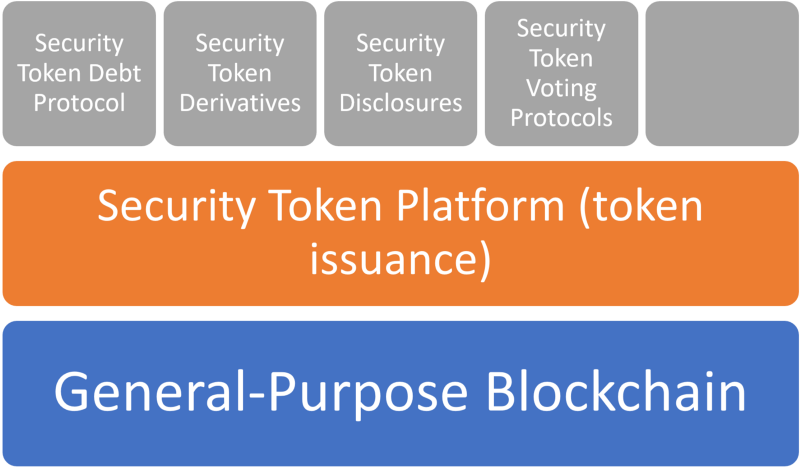Do Security Tokens Need a New Blockchain? Benefits and Challenges Part II
By Laura Desmond
This is the second part of an essay that debates the value proposition of a new blockchain for security tokens. In the first part, we discussed some of the challenges of the current generation of security token platforms that justify the case for a new blockchain for security tokens. Today, I would like to take the contrarian argument and explain some of the arguments against that value proposition. In the same way that several people disagree with my previous article dissecting the case in favor of a new blockchain runtime for crypto-securities, I expect another segment of the community to disagree with the points expressed in this article. My goal is to foment a pragmatic debate based on technical and financial rigor and not in passionate positions.
The idea of a blockchain specialized in security tokens is compelling conceptually but has some tangible challenges both technologically and from the market strategy standpoint. Designing a new blockchain for crypto-securities is a very complex exercise and factoring in the correct challenges can contribute to a positive outcome. Let’s explore some of those arguments in more details from both a philosophical and a technical standpoint.
Infrastructure Without Applications
There is no doubt that the infrastructure in the security token space is very immature but so are the projects. Historically, the best infrastructure building blocks are those created to support strong use cases. The Federal Reserve was created at a time in which the United States had a strong need for a central bank and the IPhone came out at the time that the world’s communication were ready for an explosion of mobile apps.
At the moment, we haven’t really seen the breakthrough use cases that are going to drive the security token industries and most projects are simple tokenized representations of existing vehicles such as shares. From that perspective, it seems that a security token blockchain will be an exercise of abstracting building blocks for problems we have not seen yet. The brilliant writer William Gibson once said “the future is here, it’s just not evenly distributed”. Maybe we need to allow crypto-securities to evolve a bit before we start trying to build a new tier1 runtime for them.

Security Token Dynamics are a Tier2 Problem
The main argument justifying a blockchain specialized in crypto-securities is to express ownership claims as a native construct in a blockchain. The counterargument to that point can be broken down into two main ideas. First, there is the notion that we can express ownership claims in today’s blockchains both legally and technically so there is no need for a new runtime. The second argument is even more interesting and is based on the idea that the ownership dynamics of different asset classes such as bonds, commodities or derivatives are complex enough that they are better expressed as tier 2 protocols built on top of a general-purpose blockchain.
Let’s try to expand on this argument by using a the example of a tokenized real estate investment trust(tREIT). A tREIT might bundle a series of real estate debt and equity assets in a single tradeable unit. The token representing the tREIT needs to account for complex dynamics such as risk, rebalancing, debt defaults etc. Those complex dynamics can’t be implemented using simple ownership abstractions and most likely will require a general-purpose programming language such as Solidity. In that scenario, the value of a blockchain for security tokens in comparison to Ethereum is very diminished at best.

Ethereum Protocol Landscape
Security token models require a lot of different protocols ranging from crypto-financial primitives such as debt and derivatives to disclosures, voting and many others. Despite all the challenges Ethereum has as a platform, it has managed to nurture a rich ecosystem of protocols that are very relevant in the security token space. Starting with a new blockchain for crypto-securities will essentially mean to neglect that amazing IP and start building from the ground up. Certainly not impossible but, arguably, not the greatest strategy in a nascent market.
The Utility Token Problem
Any new blockchain for security tokens is going to require an underlying currency to incentivize the participants in the network. As any new cryptocurrency, this token will go through long periods of instability and will be subjected to market manipulations. From a crypto-economic standpoint, I worry about the viability of modeling dynamics for relatively stable assets using a new and unstable utility token. I know this argument might sound a bit speculative but it has some strong economical foundation. Generally speaking, new asset classes should be pegged to relatively stable financial vehicles like currencies. If not, the effort will not only be building a new blockchain for security tokens but also building a new and relatively stable cryptocurrencies. Platforms like EOS and Stellar have been able to accomplish that but they also raise ridiculous amounts of money.
Vulnerability to Second Generation Blockchains
My final argument against the thesis of a security token blockchain has to do with market defensibility. We have seen an entire generation of new blockchains that are more efficient than Ethereum in terms of scalability and richer programming models but they have struggled to displace Ethereum in terms of market share. Algorand, Zilliqa, EOS, NEO, Hedera Hasgraph, DFINITY are some examples of blockchains in this group. Security tokens offers a blank canvas for these second generation blockchains to compete with Ethereum in a relatively even playfield. From that perspective, it won’t be very hard for those blockchains to incorporate support for security tokens in addition to their already rich runtimes. In that scenario, the value proposition of a blockchain specialized in security token becomes questionable as we will have many robust runtimes adding tier2 protocols to support crypto-securities.
I understand that some of the arguments expressed in this part are going to spark some debate but hopefully will help you to think about the case for a blockchain for crypto-securities. In the next part, we are going to deep dive into this subject from a technical standpoint and explore what components or protocols should be included in the blockchain for security tokens.

